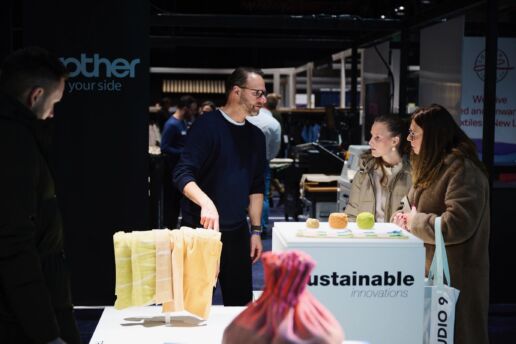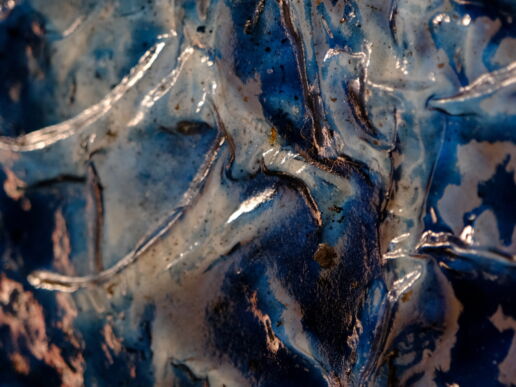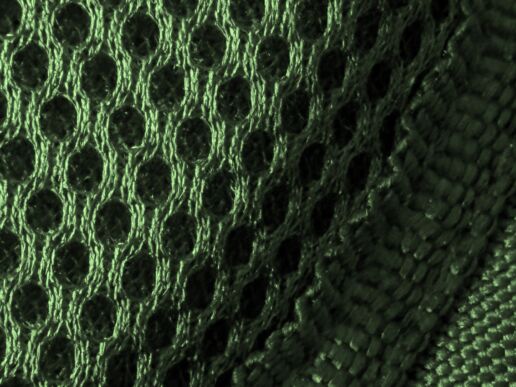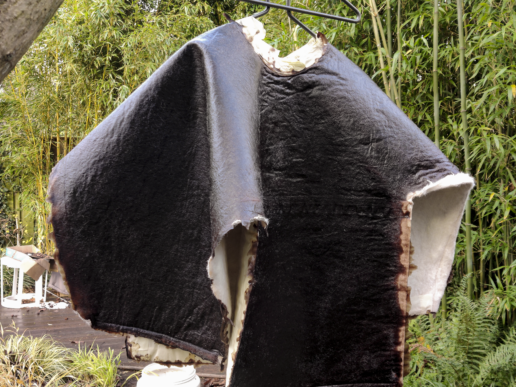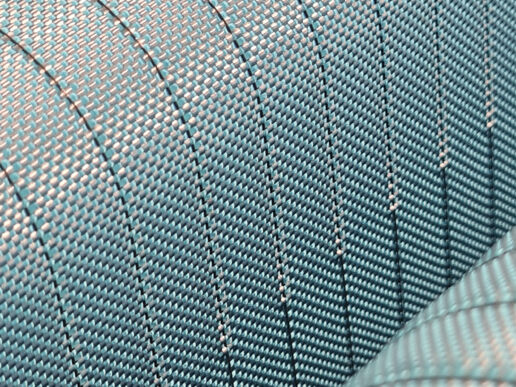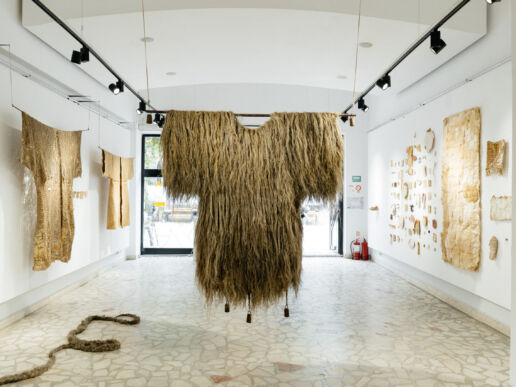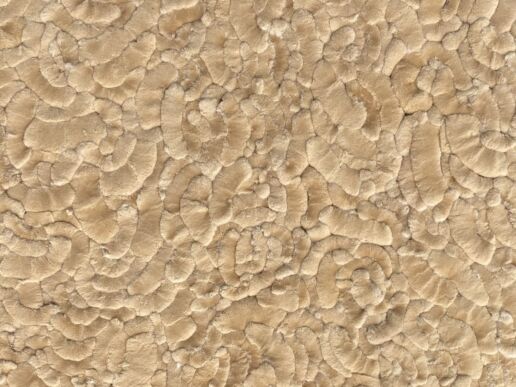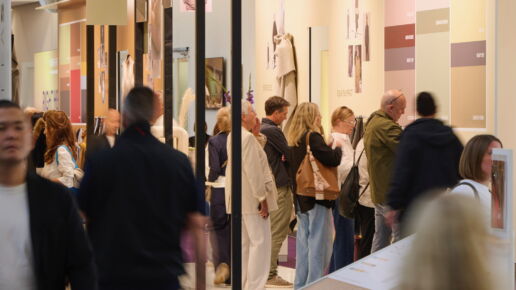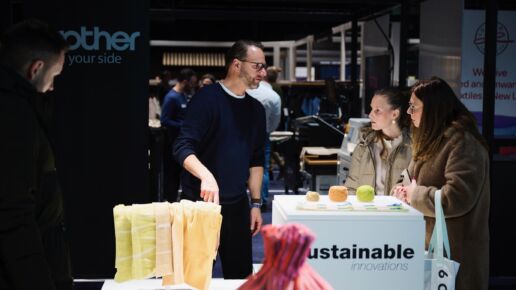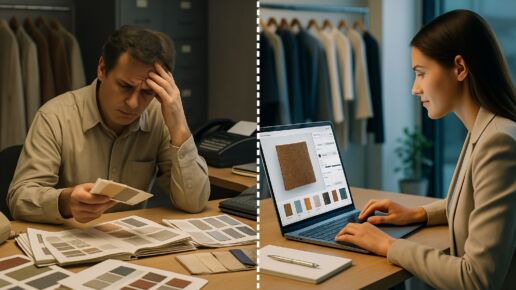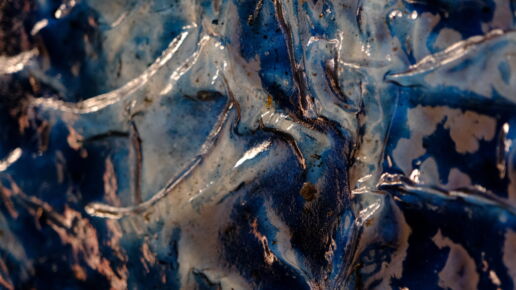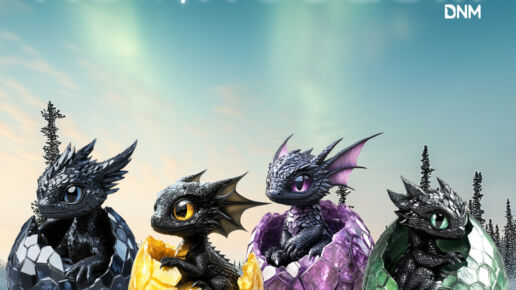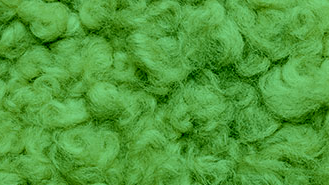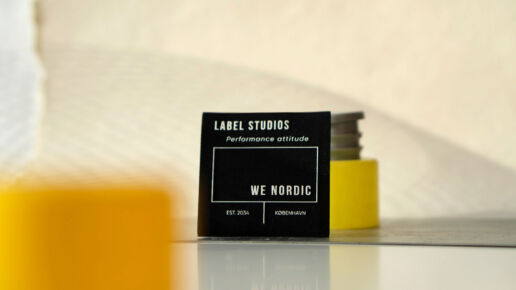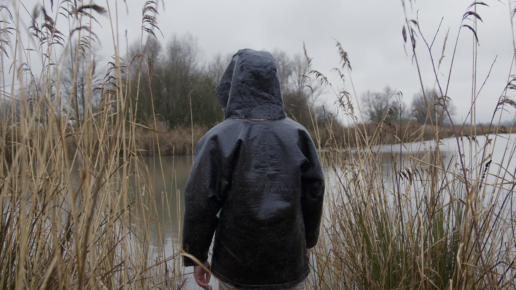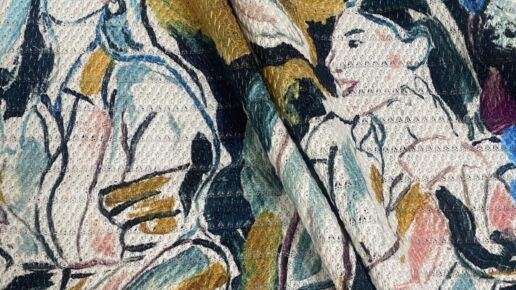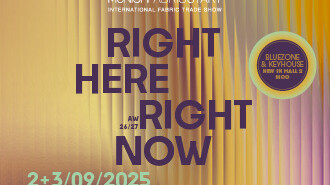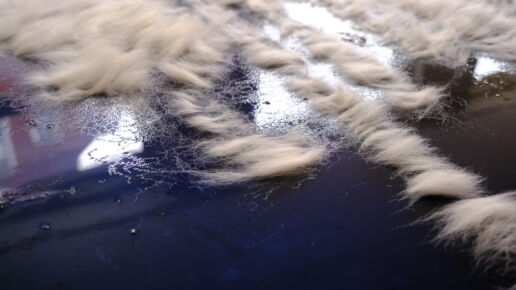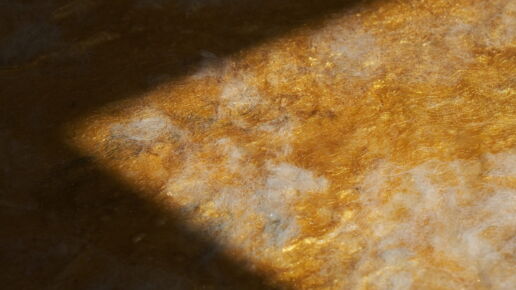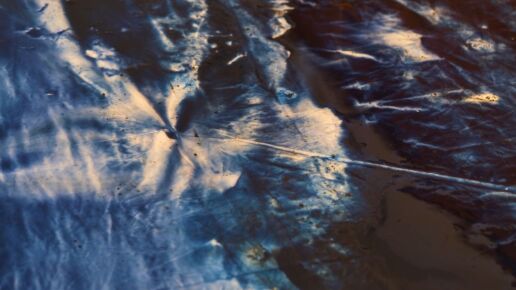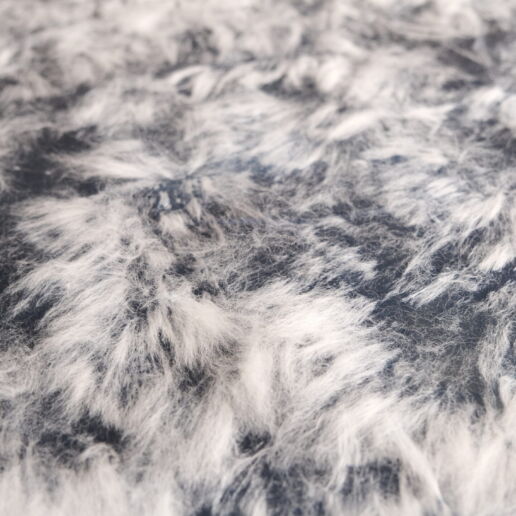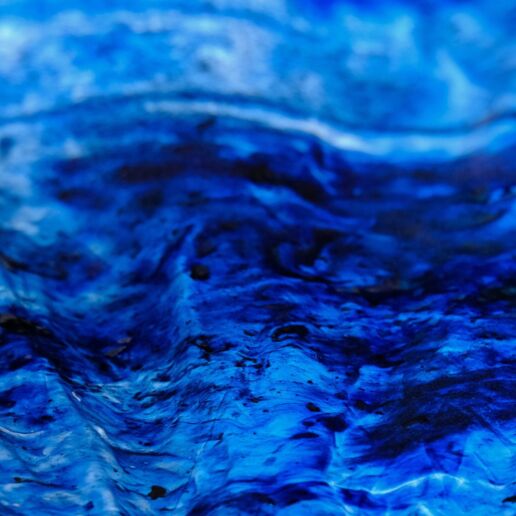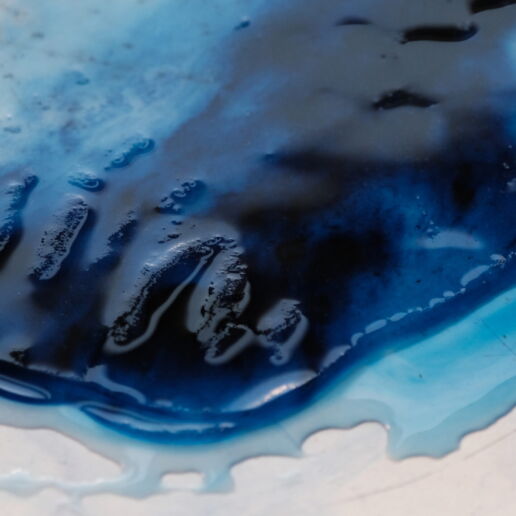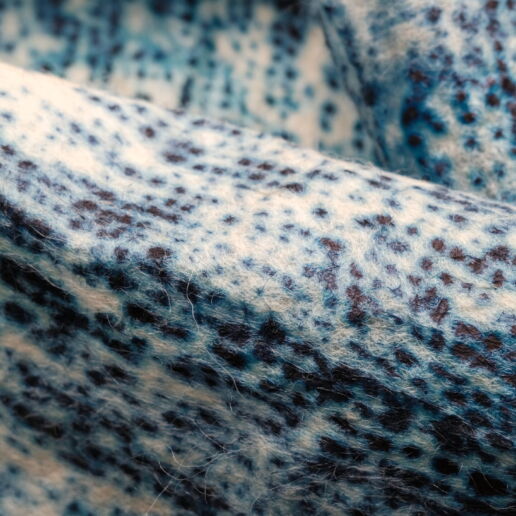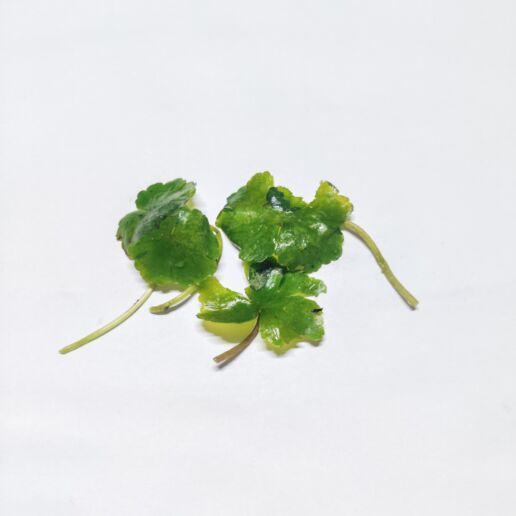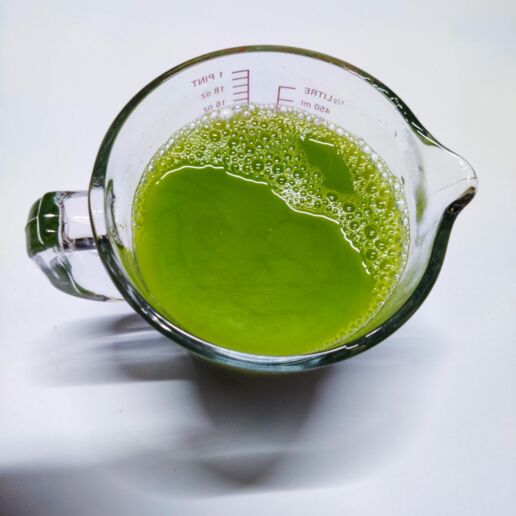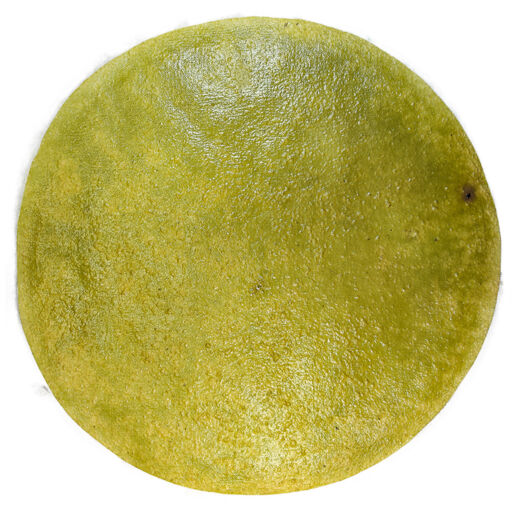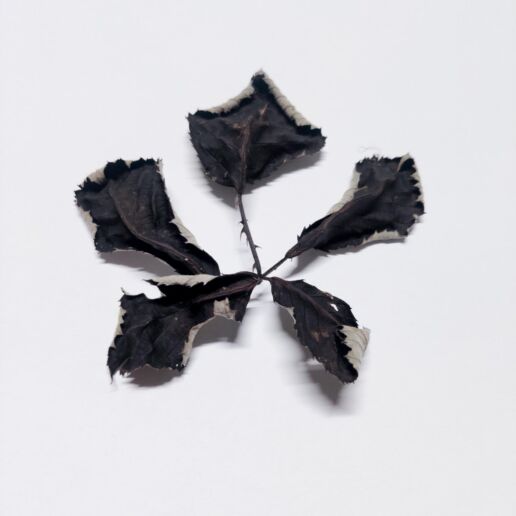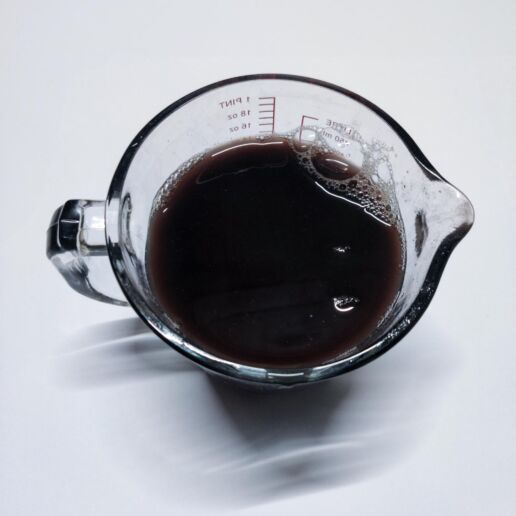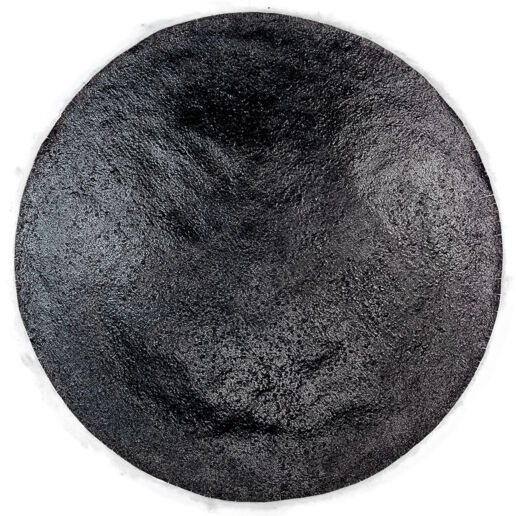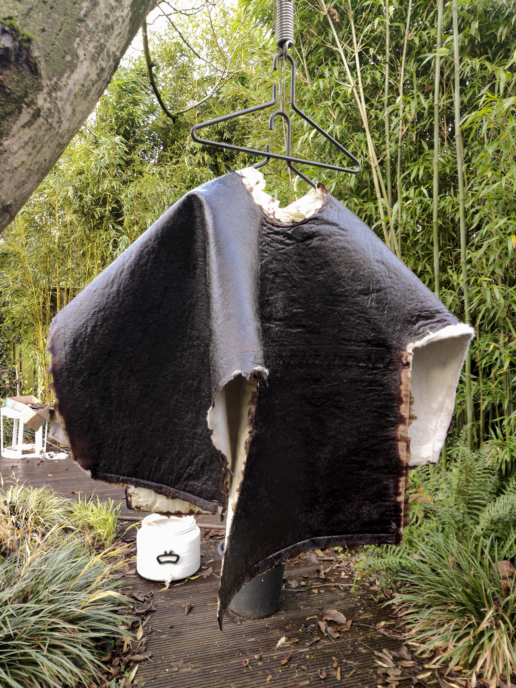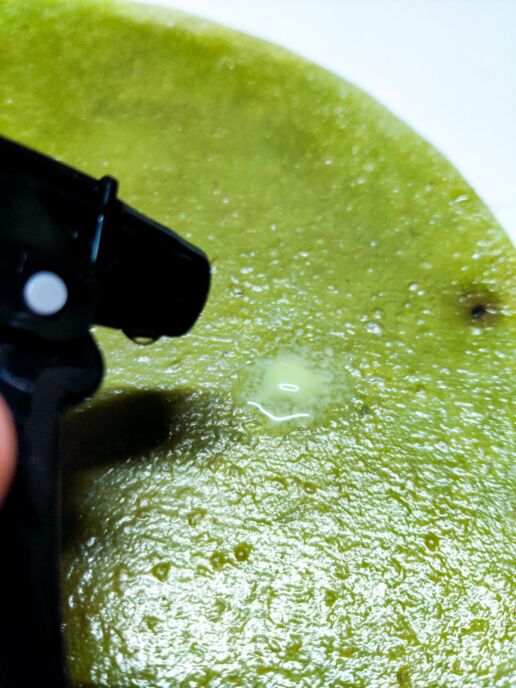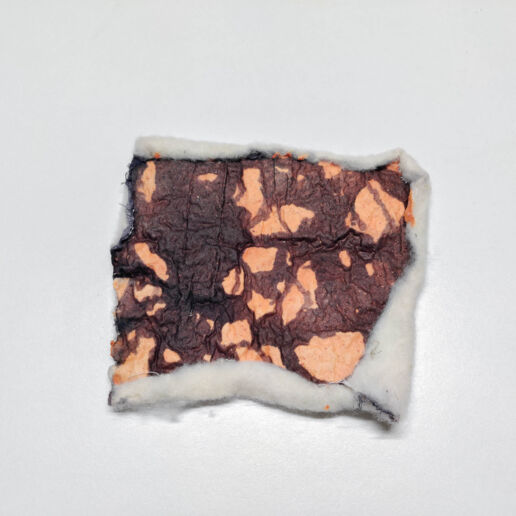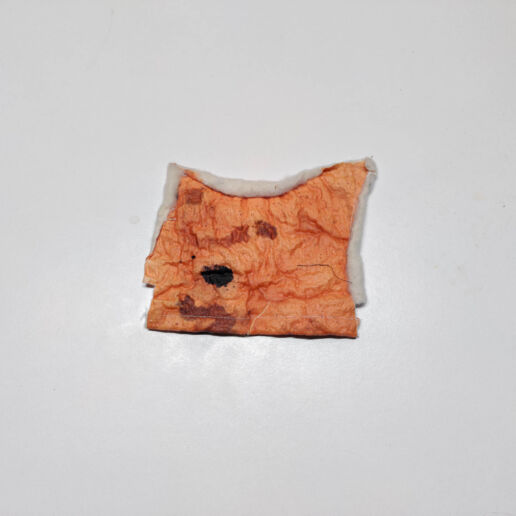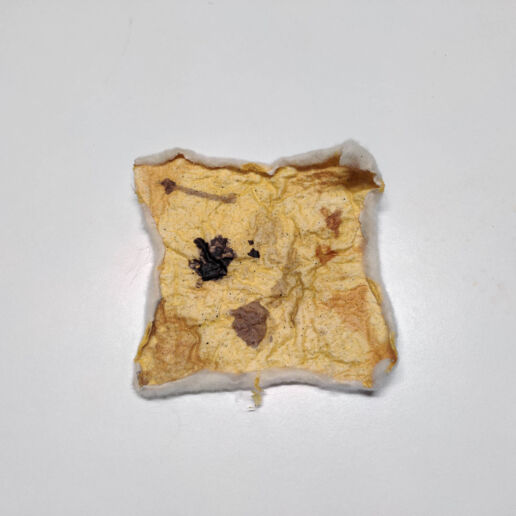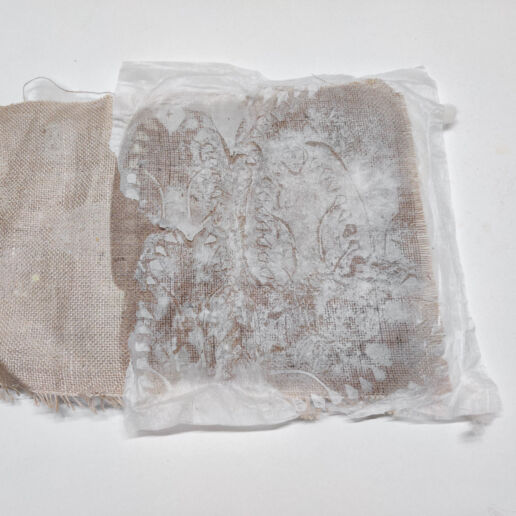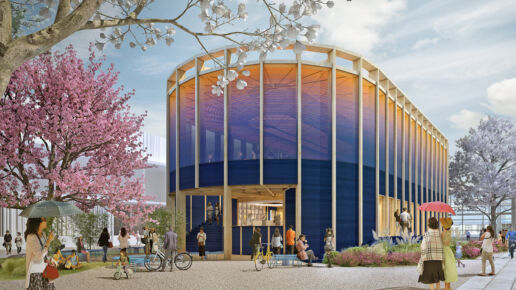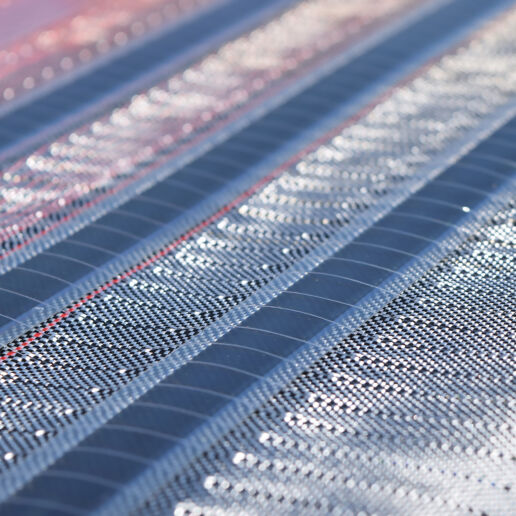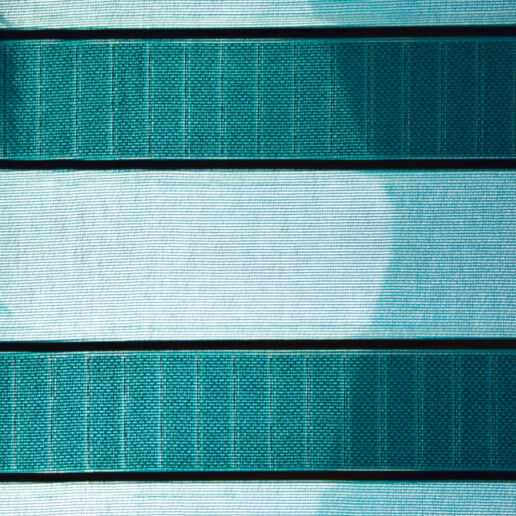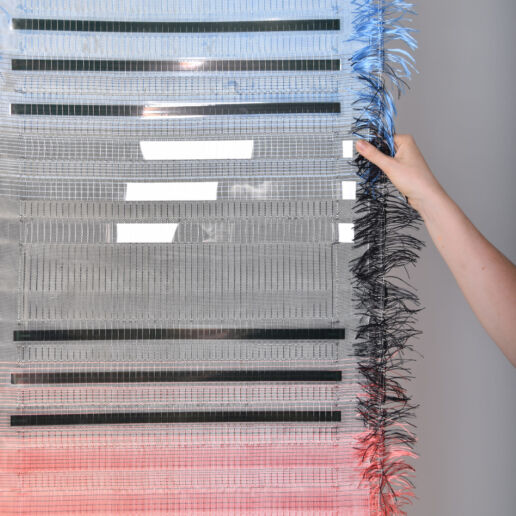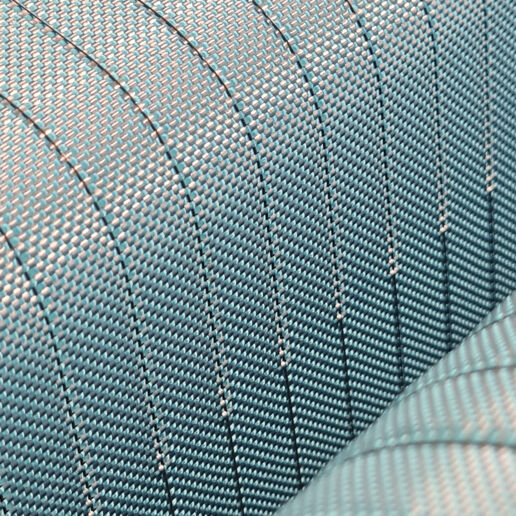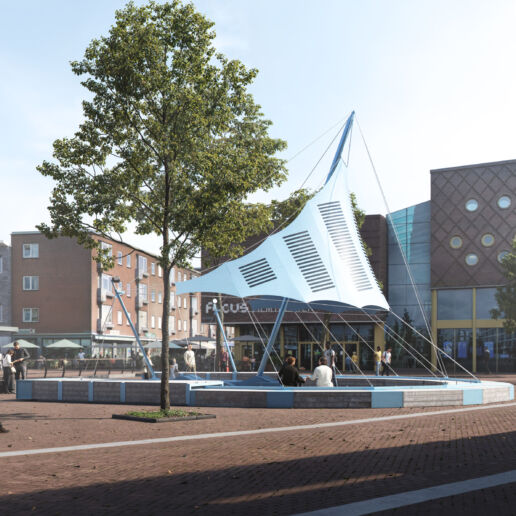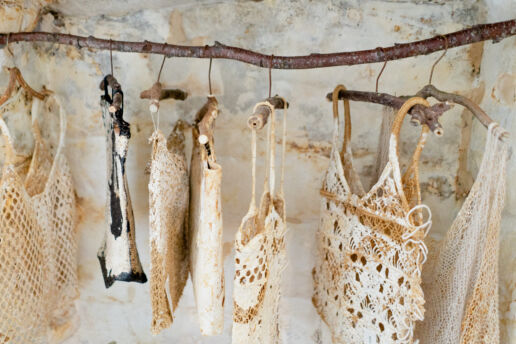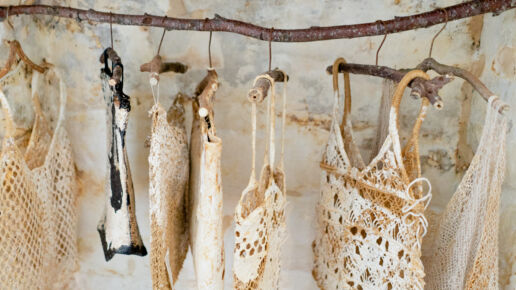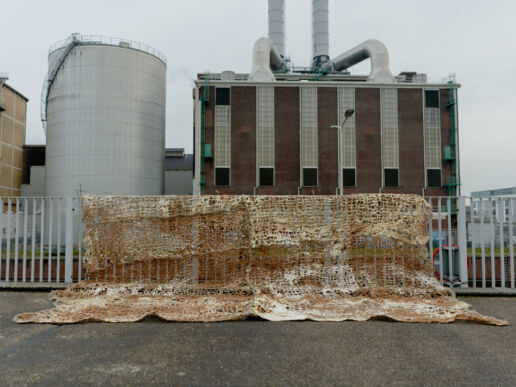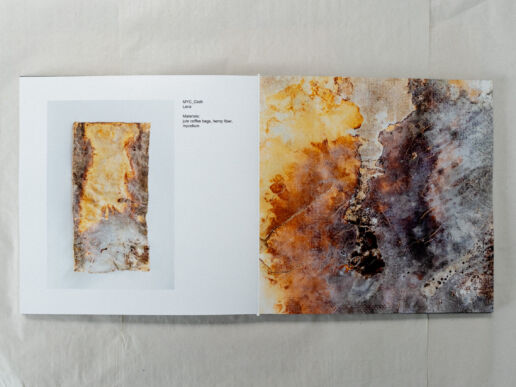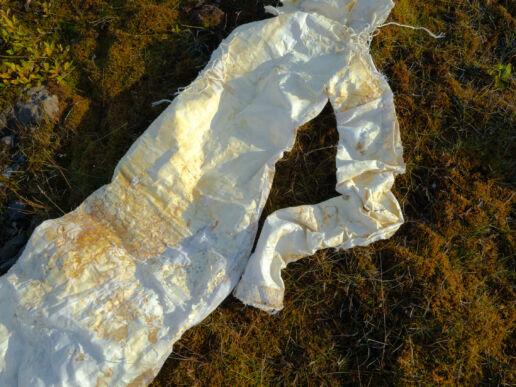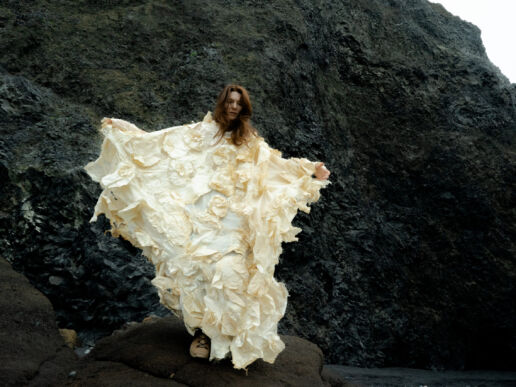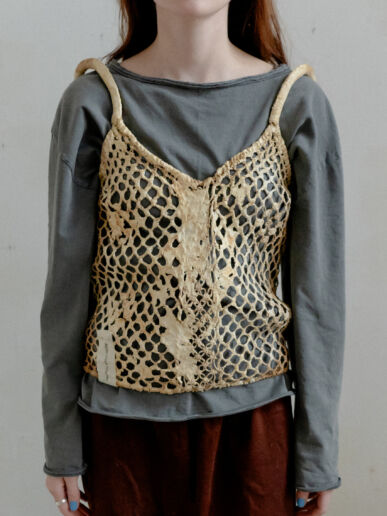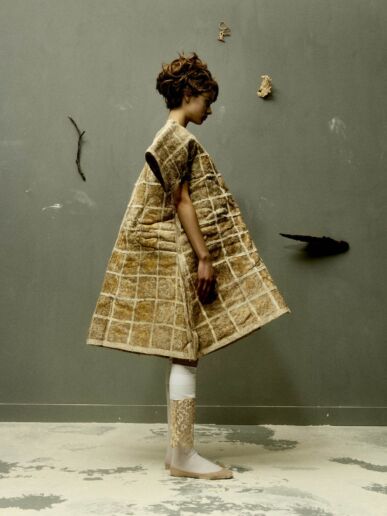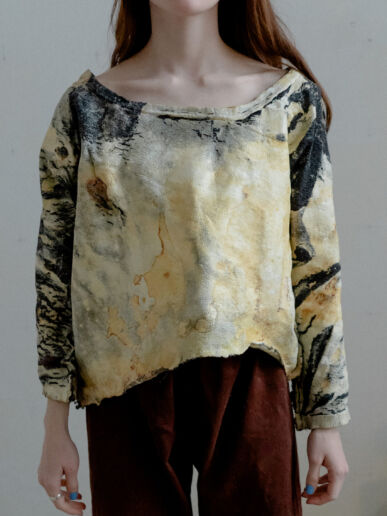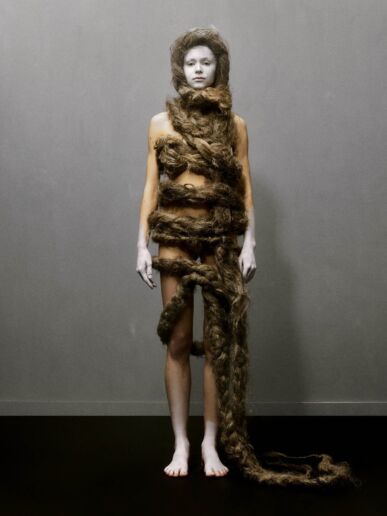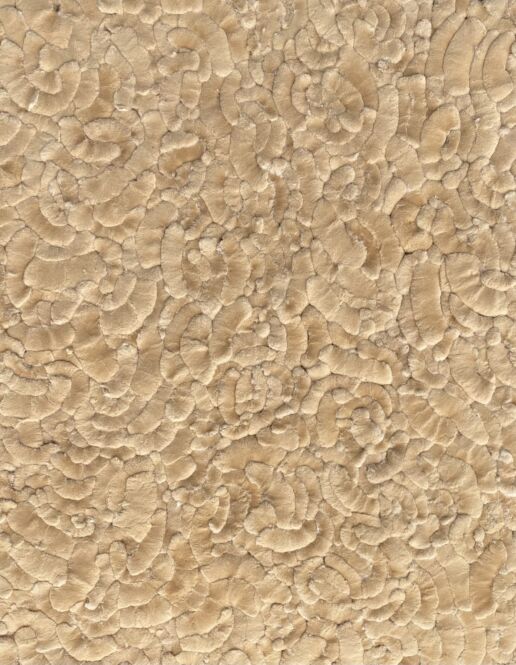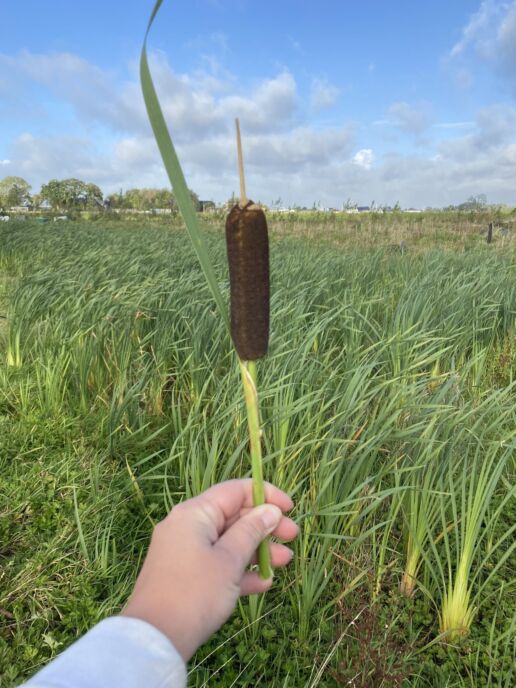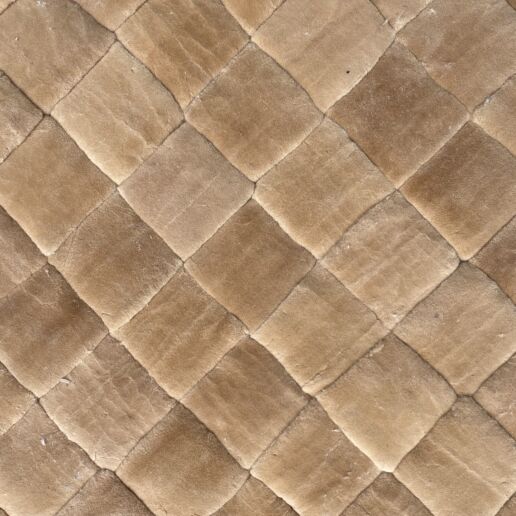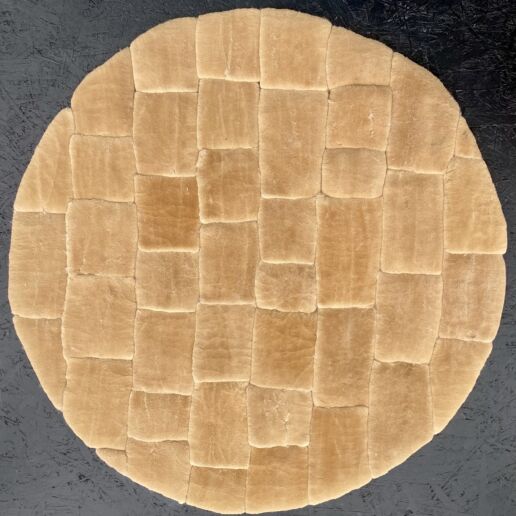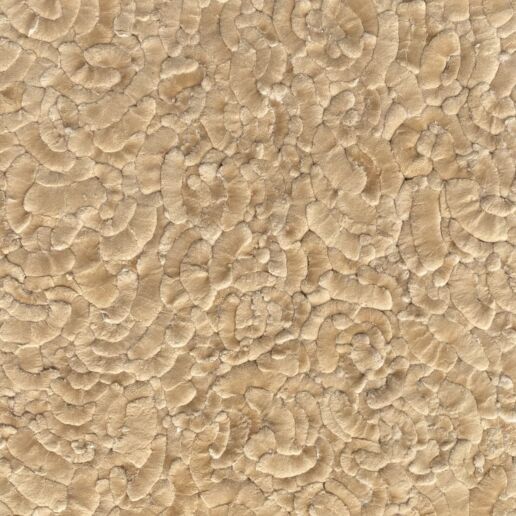Sustainable Innovations
Materials as Agents of Change with Simon Angel
Curator of SUSTAINABLE INNOVATIONS at Munich Fabric Start, Simon Angel, has become a central voice in shaping how the fashion and textile industries engage with change. His role is less about gatekeeping and more about storytelling. He is someone who is continually driven to connect experimental design, science, and industry practice into a broader vision of what the future of textiles could be. Each season, the forum brings together projects that provoke, inspire, and challenge assumptions. This year is no exception, with work ranging from bio-luxury couture to energy-generating textiles and regenerative materials grown from wetlands.
Here, Angel reflects on his curatorial approach, what unites the innovators he spotlights, and the lessons the wider industry should take forward.
What guides your selection for the Sustainable Innovations forum at Munich Fabric Start?
Simon Angel: I tend to follow what I’d call the heartbeat of our shared future. I’m drawn to ideas that question how we live, how we make, and what we value. That’s why you’ll see projects like Wetlands Matters, which asks whether a jacket can actually help re-wild landscapes, or MYC_couture, which shows us that couture can be cultivated with fungi rather than constructed with synthetics. Innovation often blooms at intersections between fashion, materials science, agriculture, and energy. What matters is that each project shines light on a new way to connect design, ecology, and purpose.
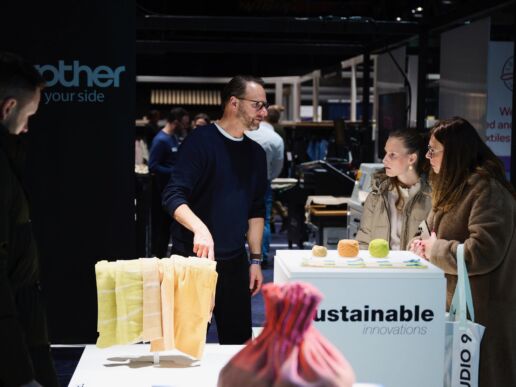
What unites the projects featured this season?
Simon Angel: Two things: poetry and purpose. We need creators who can stir emotion like Plantfur, which transforms cattail waste into fur-like panels that are both tactile and ecological and at the same time we need rigorous problem-solvers who deliver scalable results, like the BIOTEXFUTURE initiative working on bio-based polyester and recyclable spacer fabrics. When those elements come together, the projects become more than exhibits; they become signals of what the industry could look like in ten or twenty years.
Do you sense any trends taking shape across the entries this season?
Simon Angel: What I see is a search for meaningful connection between people, and between materials and purpose. Suntex, for example, doesn’t just provide shade it turns fabric into renewable infrastructure, powering spaces we live in. Living Matter reframes luxury not as excess but as responsibility. These are projects asking: why do we value what we value, and what role can textiles play in helping us live differently? That drive for connection may be the next frontier of innovation.
What can the industry learn from the Sustainable Innovations forum?
Simon Angel: The forum isn’t about providing ready-made answers. It’s about opening a dialogue. Designers bring unique perspectives on human need and material potential, while industry brings the scale and reach to make change happen. When something like Wetlands Matters or Plantfur is staged next to an industrial research programme like BIOTEXFUTURE, it shows how speculative design and applied science can reinforce one another. That’s when we move from admiration to action.
Looking ahead, how do you see sustainability and textiles evolving together?
Simon Angel: The more immersed I become, the more it boils down to responsibility shared across the system. For me the projects at Sustainable Innovations remind us that awareness can be turned into collective action. It’s time for the industry to let that enthusiasm drive renewal, not just conversation.

About the author
Founding editor-in-chief of Shape Innovate, Muchaneta has worked in the fashion industry for over 14 years. She is currently one of the leading influencers speaking and writing about the merger of fashion with technology and wearable technology.
Muchaneta ten Napel | m@shapeinnovate.com
THIS MIGHT BE ALSO INTERESTING FOR YOU:
MUNICH FABRIC START – September 25 closing report
4. September 2025
At its 56th edition, MUNICH FABRIC START reinforced its clear positioning. Over two days, the Munich textile trade show brought the fashion industry together with its four show-in-show formats.
Materials as Agents of Change with Simon Angel
1. September 2025
Each season, the Sustainable Innovations forum brings together projects that provoke, inspire, and challenge assumptions. This year is no exception, with work ranging from bio-luxury couture to energy-generating textiles and regenerative materials grown from wetlands.
AUTUMN.WINTER 26/27 FABRIC HIGHLIGHTS & MATERIAL NOVELTIES – PART X
31. August 2025
For the first time in Germany, S2G XR (Style 2 Garment eXtended Reality) will present a live demo of its 3D textile configurator at booth A4.20 Not a teaser.
Living Matter: Bio-Luxury for Future Materials
31. August 2025
Indigo, a colour with a lot of history, is the main focus of this project. Denim has always meant strength and durability, and its roughness is linked to work and usefulness.
BLUEZONE NEWS FOR SEPTEMBER 2025 – PART VI
31. August 2025
At DNM Denim, the journey continues. Inspired by nature’s cycles and guided by Flow Theory, the company moves from Challenge to Focus, and now to Freedom—the phase where potential becomes power.
BIOTEXFUTURE: How to Make Textiles from Fossils
30. August 2025
The program is a group of businesses and universities working together to find scalable, bio-based alternatives.
Additionals Trends Autumn.Winter 26/27 – Part 8
30. August 2025
This collection embodies softness, simplicity, and flow – from soft-touch labels and stretchable materials that move with the body, to a calming palette of pastel tones and organic, natural fibers.
Wetlands Matters – by Marc Wijkmans
29. August 2025
Wijkman’s idea came from a simple but important observation: animals carry seeds across ecosystems in their fur.
AUTUMN.WINTER 26/27 FABRIC HIGHLIGHTS & MATERIAL NOVELTIES – PART IX
29. August 2025
The designs embrace various trend themes – sometimes subtle, sometimes expressive – and lend each fabric its own distinctive character.
MUNICH FABRIC START September 2025 – Outlook
29. August 2025
The countdown is on: in just three weeks, Munich will once againbecome the epicentre of the European fashion and textile industry. During the first week ofSeptember, MUNICH FABRIC START Exhibitions GmbH will unite all key fashion segments underone roof, reaffirming its position as one of Europe’s leading textile trade shows.
Living Matter: Bio-Luxury for Future Materials
Luxury has always been a contradiction. It’s admired for its craft and allure, yet criticised for its excess. Living Matter takes this tension and turns it into a question: what if luxury wasn’t about being rare or exclusive, but about being responsible and creative?
Indigo, a colour with a lot of history, is the main focus of this project. Denim has always meant strength and durability, and its roughness is linked to work and usefulness. In this case, indigo is used to provoke. Biomaterials like Indigo Fur, Indigo BioLeather, and Indigo Veil change the roughness of denim into something soft, light, and impossibly elegant. These materials are made to feel high-end, but they are also made to change, age, and eventually return to the earth.
The process uses marine biopolymers, plant fibres, and even charcoal waste, which are mixed with cotton and natural indigo dyes. The results are more than just surfaces; they are shaped by techniques like folding, pleating, and fur-crafting. They feel alive, with both a scientific and a craft-like touch. Every piece tells a story about what happens when old and new come together.
“By rethinking luxury as a nature-driven, craftsmanship-based concept, the project pioneers sustainable luxury.”
Shushanik Droshakiryan
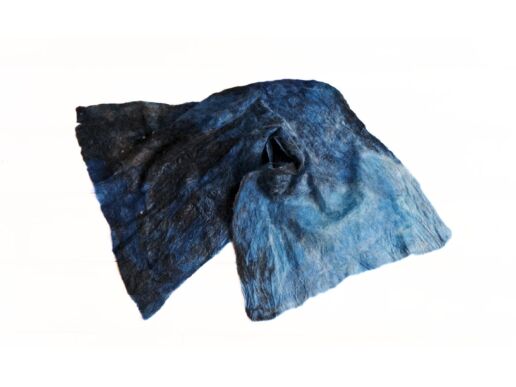
What stands out is how beautiful these materials are without any shame. Sustainable design is too often shown in muted colours, as if restraint is the only way to show responsibility. Living Matter has a different point of view. Indigo here is strong and bright, with textures that are rich, sensory, and very appealing. It doesn’t agree that taking care of the planet means giving up style.
Luxury sets the tone for the wider industry, shaping what people desire and why they engage with fashion at all. Living Matter challenges this influence, urging a shift away from extraction toward stewardship redefining bio-based materials not as compromise, but as the ultimate expression of desirability.
Presented at the September 2025 edition of Munich Fabric Start’s Sustainable Innovations forum, the project will make its case in the right place thanks to the kind collaboration with OFFICINA +39 as supplier of RECYCROMTM RTD OCEAN dye as well as EU COTTON who provided the raw cotton used in this project. Pushing boundaries and spotlighting visions of fashion’s future, it has the potential to reframe bio-based materials not as substitutes or compromises, but as the new height of aspiration.
H2 | SI
THIS MIGHT BE ALSO INTERESTING FOR YOU:
MUNICH FABRIC START – September 25 closing report
4. September 2025
At its 56th edition, MUNICH FABRIC START reinforced its clear positioning. Over two days, the Munich textile trade show brought the fashion industry together with its four show-in-show formats.
Materials as Agents of Change with Simon Angel
1. September 2025
Each season, the Sustainable Innovations forum brings together projects that provoke, inspire, and challenge assumptions. This year is no exception, with work ranging from bio-luxury couture to energy-generating textiles and regenerative materials grown from wetlands.
AUTUMN.WINTER 26/27 FABRIC HIGHLIGHTS & MATERIAL NOVELTIES – PART X
31. August 2025
For the first time in Germany, S2G XR (Style 2 Garment eXtended Reality) will present a live demo of its 3D textile configurator at booth A4.20 Not a teaser.
Living Matter: Bio-Luxury for Future Materials
31. August 2025
Indigo, a colour with a lot of history, is the main focus of this project. Denim has always meant strength and durability, and its roughness is linked to work and usefulness.
BLUEZONE NEWS FOR SEPTEMBER 2025 – PART VI
31. August 2025
At DNM Denim, the journey continues. Inspired by nature’s cycles and guided by Flow Theory, the company moves from Challenge to Focus, and now to Freedom—the phase where potential becomes power.
BIOTEXFUTURE: How to Make Textiles from Fossils
30. August 2025
The program is a group of businesses and universities working together to find scalable, bio-based alternatives.
Additionals Trends Autumn.Winter 26/27 – Part 8
30. August 2025
This collection embodies softness, simplicity, and flow – from soft-touch labels and stretchable materials that move with the body, to a calming palette of pastel tones and organic, natural fibers.
Wetlands Matters – by Marc Wijkmans
29. August 2025
Wijkman’s idea came from a simple but important observation: animals carry seeds across ecosystems in their fur.
AUTUMN.WINTER 26/27 FABRIC HIGHLIGHTS & MATERIAL NOVELTIES – PART IX
29. August 2025
The designs embrace various trend themes – sometimes subtle, sometimes expressive – and lend each fabric its own distinctive character.
MUNICH FABRIC START September 2025 – Outlook
29. August 2025
The countdown is on: in just three weeks, Munich will once againbecome the epicentre of the European fashion and textile industry. During the first week ofSeptember, MUNICH FABRIC START Exhibitions GmbH will unite all key fashion segments underone roof, reaffirming its position as one of Europe’s leading textile trade shows.
BIOTEXFUTURE: How to Make Textiles from Fossils
One of fashion’s biggest contradictions is that it relies on fossil fuels. Polyester, nylon, and acrylic make up most of the world’s fibres, which means that most clothes today start out as crude oil. adidas and RWTH Aachen University are leading the German project BIOTEXFUTURE, which wants to end that dependence.
The program is a group of businesses and universities working together to find scalable, bio-based alternatives. It is funded by the Federal Ministry of Education and Research. Part of the SUSTAINABLE INNOVATIONS forum at Munich Fabric start, three main projects will be featured:
- CircWool: a process that uses a solvent to restore wool fibres without lowering their quality.
- BioPETex: a bio-based polyester that works just as well as regular PET.
- BioCushion: a type of spacer fabric that can be recycled and used in shoes and clothes. It is both strong and circular.
These projects are not meant to be one-time tests; they are meant to be useful in the real world. Adding them to the forum ties speculative design ideas to a long history of applied science. It reminds us that we need both creativity and infrastructure to make the switch to sustainable textiles.
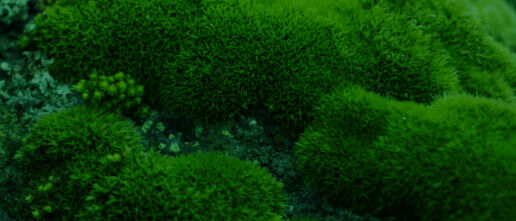
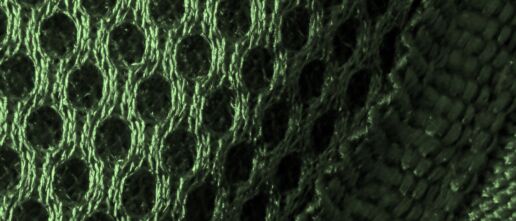
BioCushion
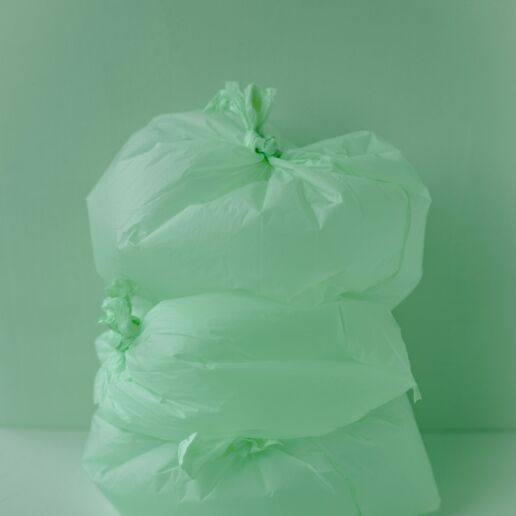
BioPEtex
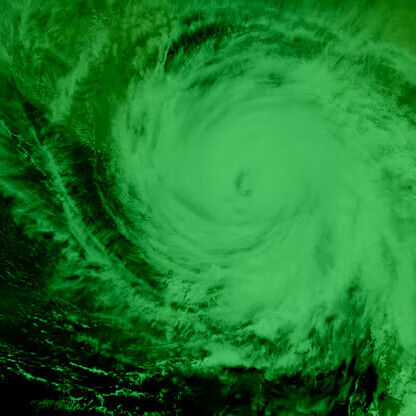
BioPEtex
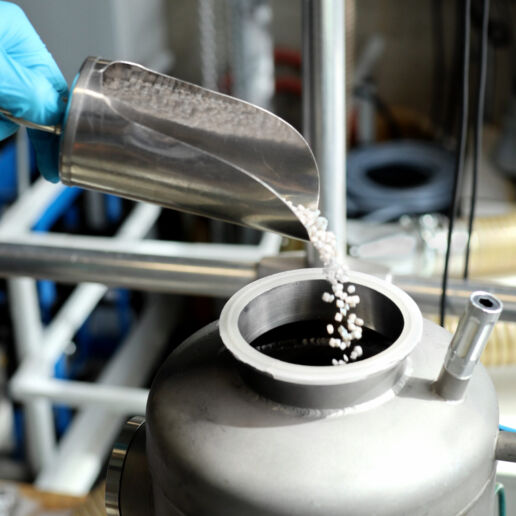
BioPEtex
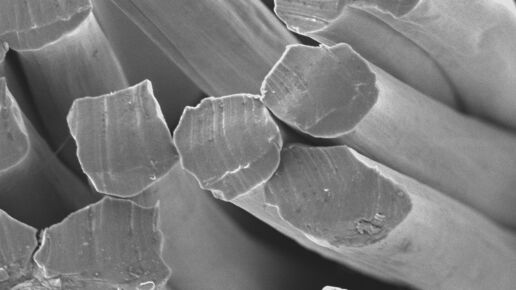
CircWool
BIOTEXFUTURE is holding the right vision to transform the textile value chain.”
adidas Future Team
The message is clear for fashion and textiles: greenwashing can’t hide the fact that we depend on oil. We need to change the way things are built, and bio-based fibres are a big part of that. The good news is that the technology is available, partnerships are forming, and interest is growing.
Petrochemistry has defined textiles for the last 100 years. But projects like BIOTEXFUTURE show that a new era is coming, one where performance, style, and scale are no longer tied to oil but to renewable innovation.
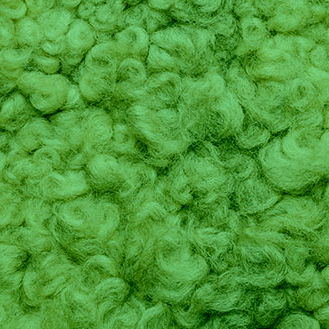
CircWool
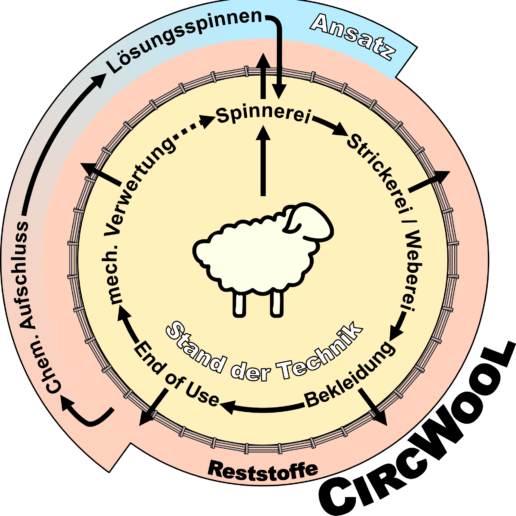
CircWool
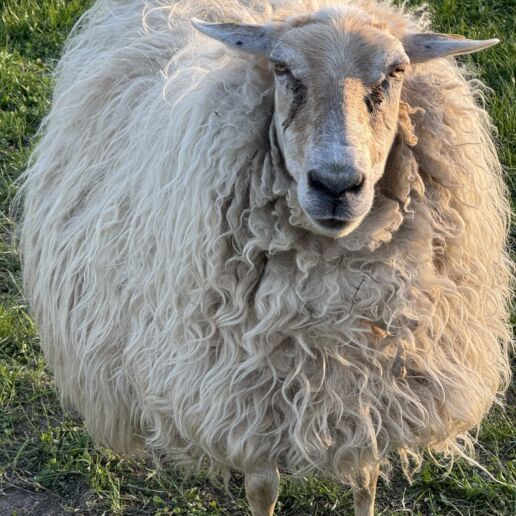
CircWool
Visit BIOTEXFUTURE H2 | SI
THIS MIGHT BE ALSO INTERESTING FOR YOU
MUNICH FABRIC START – September 25 closing report
4. September 2025
At its 56th edition, MUNICH FABRIC START reinforced its clear positioning. Over two days, the Munich textile trade show brought the fashion industry together with its four show-in-show formats.
Materials as Agents of Change with Simon Angel
1. September 2025
Each season, the Sustainable Innovations forum brings together projects that provoke, inspire, and challenge assumptions. This year is no exception, with work ranging from bio-luxury couture to energy-generating textiles and regenerative materials grown from wetlands.
AUTUMN.WINTER 26/27 FABRIC HIGHLIGHTS & MATERIAL NOVELTIES – PART X
31. August 2025
For the first time in Germany, S2G XR (Style 2 Garment eXtended Reality) will present a live demo of its 3D textile configurator at booth A4.20 Not a teaser.
Living Matter: Bio-Luxury for Future Materials
31. August 2025
Indigo, a colour with a lot of history, is the main focus of this project. Denim has always meant strength and durability, and its roughness is linked to work and usefulness.
BLUEZONE NEWS FOR SEPTEMBER 2025 – PART VI
31. August 2025
At DNM Denim, the journey continues. Inspired by nature’s cycles and guided by Flow Theory, the company moves from Challenge to Focus, and now to Freedom—the phase where potential becomes power.
BIOTEXFUTURE: How to Make Textiles from Fossils
30. August 2025
The program is a group of businesses and universities working together to find scalable, bio-based alternatives.
Additionals Trends Autumn.Winter 26/27 – Part 8
30. August 2025
This collection embodies softness, simplicity, and flow – from soft-touch labels and stretchable materials that move with the body, to a calming palette of pastel tones and organic, natural fibers.
Wetlands Matters – by Marc Wijkmans
29. August 2025
Wijkman’s idea came from a simple but important observation: animals carry seeds across ecosystems in their fur.
AUTUMN.WINTER 26/27 FABRIC HIGHLIGHTS & MATERIAL NOVELTIES – PART IX
29. August 2025
The designs embrace various trend themes – sometimes subtle, sometimes expressive – and lend each fabric its own distinctive character.
MUNICH FABRIC START September 2025 – Outlook
29. August 2025
The countdown is on: in just three weeks, Munich will once againbecome the epicentre of the European fashion and textile industry. During the first week ofSeptember, MUNICH FABRIC START Exhibitions GmbH will unite all key fashion segments underone roof, reaffirming its position as one of Europe’s leading textile trade shows.
Wetlands Matters – by Marc Wijkmans
In the Netherlands, where land and water are always at odds with each other, design often has to work with ecology. Marc Wijkmans Studio “Wetlands” takes this conversation into textiles, treating fabrics not as neutral surfaces but as active participants that can help landscapes grow.
Wijkman’s idea came from a simple but important observation: animals carry seeds across ecosystems in their fur. He made a fabric that purposely catches and spreads seeds by imitating this natural process. The material is made of wool, sodium alginate, and linseed oil, and it doesn’t have the smooth, perfect look of regular fabrics. Instead, its value comes from its flaws, how it can get stuck, carry things, and help the process of re-wilding continue. This approach goes against what people think about outdoor clothing.
“Seeds stick to fur. Building on this, I came up with the idea to give the material a fur-like surface.”
Marc Wijkmans
As most of us know, performance fabrics today are largely synthetic-engineered to be strong and water-resistant, yet infamous for shedding microplastics. Wetlands Matters challenges this conventional notion of “functionality.” Here, performance is redefined: not about keeping people dry, but about serving the ecological needs of a site.
Tested in the Hemelrijkse Waard nature reserve, the textile demonstrates that protection can be mutual – between wearer and landscape. From this emerges a clear lesson for the fashion and textile industries: materials must be rethought entirely. What if fabrics were designed to collaborate with their surroundings rather than resist them? What if impermanence and biodegradability were not flaws, but essential virtues for a sustainable future?
All in all, Wetlands Matters doesn’t say that it has a solution that is ready to sell. It works as a provocation instead: a reminder that the future of textiles may be less about how long they last and how well they work in the narrow sense and more about how they can help landscapes grow quietly and steadily.
H2 | SI
THIS MIGHT BE ALSO INTERESTING FOR YOU:
MUNICH FABRIC START – September 25 closing report
4. September 2025
At its 56th edition, MUNICH FABRIC START reinforced its clear positioning. Over two days, the Munich textile trade show brought the fashion industry together with its four show-in-show formats.
Materials as Agents of Change with Simon Angel
1. September 2025
Each season, the Sustainable Innovations forum brings together projects that provoke, inspire, and challenge assumptions. This year is no exception, with work ranging from bio-luxury couture to energy-generating textiles and regenerative materials grown from wetlands.
AUTUMN.WINTER 26/27 FABRIC HIGHLIGHTS & MATERIAL NOVELTIES – PART X
31. August 2025
For the first time in Germany, S2G XR (Style 2 Garment eXtended Reality) will present a live demo of its 3D textile configurator at booth A4.20 Not a teaser.
Living Matter: Bio-Luxury for Future Materials
31. August 2025
Indigo, a colour with a lot of history, is the main focus of this project. Denim has always meant strength and durability, and its roughness is linked to work and usefulness.
BLUEZONE NEWS FOR SEPTEMBER 2025 – PART VI
31. August 2025
At DNM Denim, the journey continues. Inspired by nature’s cycles and guided by Flow Theory, the company moves from Challenge to Focus, and now to Freedom—the phase where potential becomes power.
BIOTEXFUTURE: How to Make Textiles from Fossils
30. August 2025
The program is a group of businesses and universities working together to find scalable, bio-based alternatives.
Additionals Trends Autumn.Winter 26/27 – Part 8
30. August 2025
This collection embodies softness, simplicity, and flow – from soft-touch labels and stretchable materials that move with the body, to a calming palette of pastel tones and organic, natural fibers.
Wetlands Matters – by Marc Wijkmans
29. August 2025
Wijkman’s idea came from a simple but important observation: animals carry seeds across ecosystems in their fur.
AUTUMN.WINTER 26/27 FABRIC HIGHLIGHTS & MATERIAL NOVELTIES – PART IX
29. August 2025
The designs embrace various trend themes – sometimes subtle, sometimes expressive – and lend each fabric its own distinctive character.
MUNICH FABRIC START September 2025 – Outlook
29. August 2025
The countdown is on: in just three weeks, Munich will once againbecome the epicentre of the European fashion and textile industry. During the first week ofSeptember, MUNICH FABRIC START Exhibitions GmbH will unite all key fashion segments underone roof, reaffirming its position as one of Europe’s leading textile trade shows.
Heliotex – Studio Pauline van Dongen
Textiles have always covered our bodies, but what if they could also power the things around us? Heliotex (formerly known as Suntex), from designer Pauline van Dongen, is a challenge to what people think fabric can do.
Heliotex is basically a way to combine organic photovoltaics with lightweight, flexible fabrics. The result is sunshades and canopies that generate energy and look good at the same time. These fabrics move, fold, and breathe with their surroundings, unlike rigid solar panels. They think of renewable energy not as something that needs to be hidden away, but as something that is beautiful, soft, and fits in perfectly with the rest of the world.
“We focus on outdoor applications like textile facades, festival tents, and shade structures… Of course, we also foresee indoor applications like curtains and sun shading.”
Pauline van Dongen
The fact that Simon Angel included the project in this season’s SUSTAINABLE INNOVATIONS forum puts it in a bigger story: textiles are no longer passive. They are tools for making big changes in the system. Heliotex shows how fabrics can go beyond traditional categories by working at the intersection of design, architecture, and energy. It is similar to Wetlands Matters and Plantfur.
The effects of van Dongen’s work on the fashion and textile industries will be huge. The textile industry can grow if textiles can collect energy. Sustainability stops being about doing less harm and starts being about giving more value, like comfort, beauty, and clean energy all at once.
The lesson is practical but lofty: sustainability should feel like a part of everyday life, not something that is added on. Heliotex shows that renewable energy can be touchable, welcoming, and even luxurious. This is a call for people who work in fashion and textiles to think of fabrics not just as things we wear, but also as the buildings we live in.
H2 | SI
THIS MIGHT BE ALSO INTERESTING FOR YOU:
MUNICH FABRIC START – September 25 closing report
4. September 2025
At its 56th edition, MUNICH FABRIC START reinforced its clear positioning. Over two days, the Munich textile trade show brought the fashion industry together with its four show-in-show formats.
Materials as Agents of Change with Simon Angel
1. September 2025
Each season, the Sustainable Innovations forum brings together projects that provoke, inspire, and challenge assumptions. This year is no exception, with work ranging from bio-luxury couture to energy-generating textiles and regenerative materials grown from wetlands.
AUTUMN.WINTER 26/27 FABRIC HIGHLIGHTS & MATERIAL NOVELTIES – PART X
31. August 2025
For the first time in Germany, S2G XR (Style 2 Garment eXtended Reality) will present a live demo of its 3D textile configurator at booth A4.20 Not a teaser.
Living Matter: Bio-Luxury for Future Materials
31. August 2025
Indigo, a colour with a lot of history, is the main focus of this project. Denim has always meant strength and durability, and its roughness is linked to work and usefulness.
BLUEZONE NEWS FOR SEPTEMBER 2025 – PART VI
31. August 2025
At DNM Denim, the journey continues. Inspired by nature’s cycles and guided by Flow Theory, the company moves from Challenge to Focus, and now to Freedom—the phase where potential becomes power.
BIOTEXFUTURE: How to Make Textiles from Fossils
30. August 2025
The program is a group of businesses and universities working together to find scalable, bio-based alternatives.
Additionals Trends Autumn.Winter 26/27 – Part 8
30. August 2025
This collection embodies softness, simplicity, and flow – from soft-touch labels and stretchable materials that move with the body, to a calming palette of pastel tones and organic, natural fibers.
Wetlands Matters – by Marc Wijkmans
29. August 2025
Wijkman’s idea came from a simple but important observation: animals carry seeds across ecosystems in their fur.
AUTUMN.WINTER 26/27 FABRIC HIGHLIGHTS & MATERIAL NOVELTIES – PART IX
29. August 2025
The designs embrace various trend themes – sometimes subtle, sometimes expressive – and lend each fabric its own distinctive character.
MUNICH FABRIC START September 2025 – Outlook
29. August 2025
The countdown is on: in just three weeks, Munich will once againbecome the epicentre of the European fashion and textile industry. During the first week ofSeptember, MUNICH FABRIC START Exhibitions GmbH will unite all key fashion segments underone roof, reaffirming its position as one of Europe’s leading textile trade shows.
Atelier Dasha Tsapenko's MYC_Couture
People have long praised couture for its ability to shock. But what if fashion didn’t just shock people with its looks but also made them think about what it was made of? Atelier Dasha Tsapenko’s ongoing project, MYC_Couture, is based on that idea. Instead of making clothes, she grows them.
Tsapenko has made clothes out of fungi, hemp, and flax; living collaborations between the designer and the organism. The coats and gowns that came out of this unusual partnership are dramatic and sculptural. They look like couture fantasy, but their biology is what makes them new. The garments grow back, break down, and eventually go back to the earth. Tsapenko has introduced the new idea of “bioluxury”, which is a model that accepts change and that things don’t last, instead of fighting against change.
“Textures and materials are not produced; they grow.”
Dasha Tsapenko
This vision is not a gimmick or a small test. MYC_Couture, understands that a shift in worldview from garments as static objects to garments as part of ecological cycles isn’t about keeping things the same, it’s about celebrating change, growth, and coming back.
No stranger to events like Dutch Design Week, Copenhagen Fashion Week, and now at Munich Fabric Start, you will find MYC_Couture housed in the SUSTAINABLE INNOVATIONS space. There she hopes to start a conversation about changing the way fashion and ecology are connected. Her lesson is both simple and radical: sustainability cannot be achieved by efficiency tweaks alone.
H2 | SI
THIS MIGHT BE ALSO INTERESTING FOR YOU:
MUNICH FABRIC START – September 25 closing report
4. September 2025
At its 56th edition, MUNICH FABRIC START reinforced its clear positioning. Over two days, the Munich textile trade show brought the fashion industry together with its four show-in-show formats.
Materials as Agents of Change with Simon Angel
1. September 2025
Each season, the Sustainable Innovations forum brings together projects that provoke, inspire, and challenge assumptions. This year is no exception, with work ranging from bio-luxury couture to energy-generating textiles and regenerative materials grown from wetlands.
AUTUMN.WINTER 26/27 FABRIC HIGHLIGHTS & MATERIAL NOVELTIES – PART X
31. August 2025
For the first time in Germany, S2G XR (Style 2 Garment eXtended Reality) will present a live demo of its 3D textile configurator at booth A4.20 Not a teaser.
Living Matter: Bio-Luxury for Future Materials
31. August 2025
Indigo, a colour with a lot of history, is the main focus of this project. Denim has always meant strength and durability, and its roughness is linked to work and usefulness.
BLUEZONE NEWS FOR SEPTEMBER 2025 – PART VI
31. August 2025
At DNM Denim, the journey continues. Inspired by nature’s cycles and guided by Flow Theory, the company moves from Challenge to Focus, and now to Freedom—the phase where potential becomes power.
BIOTEXFUTURE: How to Make Textiles from Fossils
30. August 2025
The program is a group of businesses and universities working together to find scalable, bio-based alternatives.
Additionals Trends Autumn.Winter 26/27 – Part 8
30. August 2025
This collection embodies softness, simplicity, and flow – from soft-touch labels and stretchable materials that move with the body, to a calming palette of pastel tones and organic, natural fibers.
Wetlands Matters – by Marc Wijkmans
29. August 2025
Wijkman’s idea came from a simple but important observation: animals carry seeds across ecosystems in their fur.
AUTUMN.WINTER 26/27 FABRIC HIGHLIGHTS & MATERIAL NOVELTIES – PART IX
29. August 2025
The designs embrace various trend themes – sometimes subtle, sometimes expressive – and lend each fabric its own distinctive character.
MUNICH FABRIC START September 2025 – Outlook
29. August 2025
The countdown is on: in just three weeks, Munich will once againbecome the epicentre of the European fashion and textile industry. During the first week ofSeptember, MUNICH FABRIC START Exhibitions GmbH will unite all key fashion segments underone roof, reaffirming its position as one of Europe’s leading textile trade shows.
Plantfur – by Studio iFOCUS
Peatlands, which are often called the “lungs of the earth,”, are delicate ecosystems that are under a lot of stress. These carbon-rich soils in the Netherlands are at risk of collapsing because of centuries of draining and intensive farming. When they do, they release emissions into the air. This environmental crisis is not only a call to fix things, for designer Iris Veentjer; it is also a chance to rethink the future of materials.
Veentjer’s practice has turned her attention to cattails, a plant that grows well in waterlogged soils and has the potential to change both landscapes and textiles. Plantfur, a surface material made from the cigar-shaped seed heads of the cattail, is the main focus of this research. These spikes are usually thrown away as agricultural waste, but they are collected before they spread too much and turned into panels that look like fur. Each cigar has its own size, so when they are put together, they make striated surfaces that are naturally beautiful. Not only is the material a more environmentally friendly alternative to animal fur and petroleum-based synthetics, but it also gives farmers a crop that helps reduce emissions.
“Harvesting cattail cigars earlier prevents their invasive spread and transforms waste into value.”
Iris Veentjer
The fact that SUSTAINABLE INNOVATIONS forum is featuring the project this season shows how important it is. Plantfur shows that sustainability can mean more than just doing less harm. Plantfur makes important points for the fashion and textile industries. What if wetlands were used to grow fur instead of factory farms? What if farming worked with climate resilience instead of against it?
Plantfur doesn’t just replace old materials; it makes a new way to use them based on ecological reciprocity. This is a very important lesson to learn. People won’t just judge the textiles of the future by how they feel on the skin; they’ll also judge them by how they work in ecosystems. Veentjer’s work shows that luxury and sustainability don’t have to be at odds with each other. They can be redefined together with materials that are both beautiful and good for the environment.
H2 | SI
THIS MIGHT BE ALSO INTERESTING FOR YOU:
MUNICH FABRIC START – September 25 closing report
4. September 2025
At its 56th edition, MUNICH FABRIC START reinforced its clear positioning. Over two days, the Munich textile trade show brought the fashion industry together with its four show-in-show formats.
Materials as Agents of Change with Simon Angel
1. September 2025
Each season, the Sustainable Innovations forum brings together projects that provoke, inspire, and challenge assumptions. This year is no exception, with work ranging from bio-luxury couture to energy-generating textiles and regenerative materials grown from wetlands.
AUTUMN.WINTER 26/27 FABRIC HIGHLIGHTS & MATERIAL NOVELTIES – PART X
31. August 2025
For the first time in Germany, S2G XR (Style 2 Garment eXtended Reality) will present a live demo of its 3D textile configurator at booth A4.20 Not a teaser.
Living Matter: Bio-Luxury for Future Materials
31. August 2025
Indigo, a colour with a lot of history, is the main focus of this project. Denim has always meant strength and durability, and its roughness is linked to work and usefulness.
BLUEZONE NEWS FOR SEPTEMBER 2025 – PART VI
31. August 2025
At DNM Denim, the journey continues. Inspired by nature’s cycles and guided by Flow Theory, the company moves from Challenge to Focus, and now to Freedom—the phase where potential becomes power.
BIOTEXFUTURE: How to Make Textiles from Fossils
30. August 2025
The program is a group of businesses and universities working together to find scalable, bio-based alternatives.
Additionals Trends Autumn.Winter 26/27 – Part 8
30. August 2025
This collection embodies softness, simplicity, and flow – from soft-touch labels and stretchable materials that move with the body, to a calming palette of pastel tones and organic, natural fibers.
Wetlands Matters – by Marc Wijkmans
29. August 2025
Wijkman’s idea came from a simple but important observation: animals carry seeds across ecosystems in their fur.
AUTUMN.WINTER 26/27 FABRIC HIGHLIGHTS & MATERIAL NOVELTIES – PART IX
29. August 2025
The designs embrace various trend themes – sometimes subtle, sometimes expressive – and lend each fabric its own distinctive character.
MUNICH FABRIC START September 2025 – Outlook
29. August 2025
The countdown is on: in just three weeks, Munich will once againbecome the epicentre of the European fashion and textile industry. During the first week ofSeptember, MUNICH FABRIC START Exhibitions GmbH will unite all key fashion segments underone roof, reaffirming its position as one of Europe’s leading textile trade shows.
Kantamanto Social Club
A revolution is unfolding.
Kantamanto Social Club was born from inspiration brought about by the vibrant, bustling markets of Kantamanto, Ghana. Co-founders Anabel Poh and Daan Sonnemans’ objective was to transform the global fashion landscape through amplifying the practices of communities that the fashion and textile industry often overlook. The club’s initiative goes beyond mere sustainability – it’s about reshaping power dynamics in an industry that usually doesn’t empower marginalised communities.
Kantamanto Social Club’s Vision of a Circular Fashion Future
The mission of Kantamanto Social Club is clear: to empower communities in the Global South. It aims to shine a spotlight on communities, particularly those whose circular and regenerative practices have been undervalued for too long. “The core of this project centres on the inherently sustainable communities of the Global South, which have practiced regenerative methods for generations,” explained Daan. Rather than viewing these communities as recipients of Western “aid” or “guidance,” the Social Club positions them as leaders in sustainable fashion.
By focusing on a philosophy that brings traditionally marginalised voices into global discussions on environmental and economic sustainability, the club has taken on the responsibility to empower artisans who are transforming discarded textiles from the Global North into high-value fashion items. They are doing this by providing a platform that showcases the artisan’s potential, creativity, resilience and ability to demonstrate how sustainable practices can counteract global consumption excesses.
Daan poses a crucial question, “How, at the brink of collapse, can we turn the tide and transition the fashion industry towards a regenerative model?” Through these efforts, Sonnemans challenges industry norms, advocating for systemic change that prioritises ecological and social integrity.
Creating Bridges Through Art and Advocacy
Forging tangible connections between local artisans and the global stage, Kantamanto Social Club’s voice can be heard through exhibitions, storytelling, and collaborative research initiatives. These platforms not only underscore the creative potential of upcycled fashion but also offer critical commentary on the prevailing norms of production and consumption in the fashion industry. This approach sets the stage for a deeper exploration into sustainable practices.
Building on this foundation, a significant aspect of the club’s work will focus on sustainability education as a next step. Through workshops, the club will inspire and train the next generation of designers, embedding sustainable thinking right from the start of their careers. Furthermore, the club will facilitate cultural exchanges that elevate the work of Kantamanto’s creatives, giving them the international recognition they deserve. Daan poses a crucial question, “How, at the brink of collapse, can we turn the tide and transition the fashion industry towards a regenerative model?” Through these efforts, Sonnemans challenges industry norms, advocating for systemic change that prioritises ecological and social integrity.
Beyond sparking a creative resurgence, the Kantamanto Social Club actively engages in policy advocacy, influencing global strategies on waste management and sustainable practices. Their initiatives serve as a call to action, urging the international community to reconsider the values and interactions that define the fashion industry. This holistic approach ensures that the impact of their advocacy resonates beyond artistic circles, reaching into the realms of global policy and practical change.
Engage with Kantamanto Social Club
Whether you’re a designer, policy-maker, or curious observer, the Kantamanto Social Club invites you to reimagine the fashion industry—one that’s built on equity, regeneration, and genuine respect for the planet and its people. So if you are looking to dive deeper into the transformative projects of the Kantamanto Social Club or to engage with their ongoing initiatives, you can find out more via their website.
A statement on recent events
“On the night of January 1, 2025, and into the morning of the 2nd, a devastating fire swept through the Kantamanto Market, destroying as many as two-thirds of it. Over 10,000 people—tailors, retailers, kayayei, and artisans—have been affected, losing their businesses and livelihoods.
To us Kantamanto is more than a market—it has become a global symbol of resilience, transforming unwanted textiles from across the world into something meaningful. It stands as a testament to sustainable fashion and the incredible creativity of its community.
Now is the time to stand in solidarity with Kantamanto. Together, we must support this community as they rebuild. We are launching a targeted fundraising campaign for the upcyclers we work with directly. But for now, any and all support is urgently needed and can be provided by donating to The OR Foundation’s fire relief fund, which is being used to directly aid relief efforts. Support here”
THIS MIGHT BE ALSO INTERESTING FOR YOU:
MUNICH FABRIC START – September 25 closing report
4. September 2025
At its 56th edition, MUNICH FABRIC START reinforced its clear positioning. Over two days, the Munich textile trade show brought the fashion industry together with its four show-in-show formats.
Materials as Agents of Change with Simon Angel
1. September 2025
Each season, the Sustainable Innovations forum brings together projects that provoke, inspire, and challenge assumptions. This year is no exception, with work ranging from bio-luxury couture to energy-generating textiles and regenerative materials grown from wetlands.
AUTUMN.WINTER 26/27 FABRIC HIGHLIGHTS & MATERIAL NOVELTIES – PART X
31. August 2025
For the first time in Germany, S2G XR (Style 2 Garment eXtended Reality) will present a live demo of its 3D textile configurator at booth A4.20 Not a teaser.
Living Matter: Bio-Luxury for Future Materials
31. August 2025
Indigo, a colour with a lot of history, is the main focus of this project. Denim has always meant strength and durability, and its roughness is linked to work and usefulness.
BLUEZONE NEWS FOR SEPTEMBER 2025 – PART VI
31. August 2025
At DNM Denim, the journey continues. Inspired by nature’s cycles and guided by Flow Theory, the company moves from Challenge to Focus, and now to Freedom—the phase where potential becomes power.
BIOTEXFUTURE: How to Make Textiles from Fossils
30. August 2025
The program is a group of businesses and universities working together to find scalable, bio-based alternatives.
Additionals Trends Autumn.Winter 26/27 – Part 8
30. August 2025
This collection embodies softness, simplicity, and flow – from soft-touch labels and stretchable materials that move with the body, to a calming palette of pastel tones and organic, natural fibers.
Wetlands Matters – by Marc Wijkmans
29. August 2025
Wijkman’s idea came from a simple but important observation: animals carry seeds across ecosystems in their fur.
AUTUMN.WINTER 26/27 FABRIC HIGHLIGHTS & MATERIAL NOVELTIES – PART IX
29. August 2025
The designs embrace various trend themes – sometimes subtle, sometimes expressive – and lend each fabric its own distinctive character.
MUNICH FABRIC START September 2025 – Outlook
29. August 2025
The countdown is on: in just three weeks, Munich will once againbecome the epicentre of the European fashion and textile industry. During the first week ofSeptember, MUNICH FABRIC START Exhibitions GmbH will unite all key fashion segments underone roof, reaffirming its position as one of Europe’s leading textile trade shows.
Curiosity, Courage and Craftmanship
Clothes Encounters and Warmly Related Relevance
With “FLORECSENCE” as the guiding principle of MUNICH FABRIC START and TECHKNOWLEDGE for the KEYHOUSE, Simon Angel, curator of Sustainable Innovations, highlights how the projects he has chosen can redefine what’s next in fashion by challenging us to think beyond quick fixes and instead embrace a deeper, more holistic approach to sustainability.
Simon, how did you approach curating this season’s Sustainable Innovations exhibit at Munich Fabric Start?
Simon Angel: Well, I wanted the projects included in the Sustainable Innovations exhibit to signal a major shift in the textile industry. The projects I selected this season challenge us to rethink everything from raw materials to end products and production processes, whilst emphasising on sustainability as an ongoing dialogue; it sparks a broader conversation about the future of our industry, urging everyone in the textile community to consider more responsible and imaginative approaches.
Could you elaborate on how year’s philosophy manifests in the exhibited projects?
Simon Angel: Certainly! This year’s philosophy is deeply embedded in each project I’ve selected for the exhibit, particularly emphasising sustainable practices that integrate seamlessly with innovative design. Take Shushanik Droshakiryan’s “PSYCHEDELIC TEXTILES.” Her work pushes the boundaries by harnessing techniques inspired by microbiology and chemistry. Her work serves as a powerful call to action for the industry to rethink the way materials are sourced, valued, and ultimately returned to the environment. By focusing on the end-of-life phase of materials, she underscores the necessity of designing within a circular economy framework, envisioning a future where environmental stewardship and fashion innovation are seamlessly integrated.
Studio Nicky Vollebregt’s “Pollia,” “HIGHLIGHT,” and “Uncover” projects are also featured. How do they fit into this narrative?
Simon Angel: Studio Nicky Vollebregt’s projects demonstrate a holistic approach to textile innovation by exploring colour reflection, material transparency, and transformative finishing techniques. The studio isn’t just making visually striking fabrics; it’s probing our concepts of light, colour, and texture, and questioning how small interventions in the material creation process can have far-reaching environmental and usability impacts. It’s a reminder that sustainability and aesthetic appeal aren’t mutually exclusive.
Can you discuss how Daan Sonnemans’s & Anabel Poh’s”Kantamanto Social Club” enhances the themes of this exhibit?
Simon Angel: Daan Sonnemans and Anabel Poh address a critical aspect of sustainability: the human and social dimension. With “Katamanto Social Club,” he focuses on community engagement and ethical labour practices, integrating cultural heritage with environmentally responsible production. I feel that this project goes beyond material innovation because it reminds us that sustainability isn’t just about new materials or recycling; its core is about the people and communities behind the products. In a way you can call his this project a sustainable process-intervention.
Can you tell us about Milou Voorwinden’s “Explorations in 3D weaving”?
Simon Angel: Milou’s work is an excellent example of how reimagining a fundamental technique can open up entirely new possibilities. In “Explorations in 3D weaving,” she looks at the loom not just as a tool for flat textiles but as a platform for sculptural, structural forms. By combining different fibres and experimenting with density, she creates fabrics with varying properties – some rigid, some flexible. These explorations challenge the binary thinking of “fabric vs. structure,” showing how textiles can be engineered in ways that minimise material waste while expanding design potential. Her design-principle brings a shift in the design-pattern-production cycle.
Wool matters” by Beatriz Isca is another project drawing attention. How does it fit into this year’s theme?
Simon Angel: Beatriz’s “Wool matters” project underscores the value of a raw material we often take for granted. By spotlighting the processes of sourcing, cleaning, and transforming wool, she shows how something as ancient as wool can be reinterpreted for modern, eco-conscious lifestyles. She not only showcases wool’s versatility; she reveals the stories, heritage, and communities behind the fibre. I am hopeful that her perspective will encourage us to consider the entire life cycle of our materials – and the people involved – before we even start to design.
Lastly, Oscar Wentz’s AFTERLIFE “REWORK AND RETHINK YOUR OWN TRASH” project stands out. Can you shed some light on this?
Simon Angel: Oscar’s AFTERLIFE project is a bold statement on waste and consumer culture. Through upcycling discarded clothes and materials, he creates street-style garments that demonstrate how a simple change in perspective can spark a larger conversation about responsibility and resource use. It’s the perfect example of how a hands-on, interventionist approach can galvanise people to embrace more circular practices.
How do you see these innovations in the exhibition influencing the future of the textile industry?
Simon Angel: These projects collectively represent a significant shift to question what’s possible and to look at sustainability as an ongoing dialogue rather than a final box to tick. Each project showcased in the Sustainable Innovation exhibit challenges existing paradigms, pushing us closer to a world where textiles are created with both people and the planet in mind.
Thank you for sharing these insights, Simon. It’s clear that this season’s Sustainable Innovation exhibit goes beyond showcasing new materials – it’s about sparking a broader conversation on the future of our industry.
Simon Angel: My pleasure. I’m thrilled for everyone to experience these projects and be part of the conversation. I believe that it is through collective curiosity and willingness to experiment that we’ll drive real, lasting sustainable innovation.
We look forward to seeing the exhibit and witnessing how these pioneering ideas will shape what’s next in textile design.
Simon Angel: Thank you. Don’t forget to visit us at the Keyhouse in Hall 7 – we can’t wait to show you how these interventions are rewriting the future of fashion and textiles.

About the author
Founding editor-in-chief of Shape Innovate, Muchaneta has worked in the fashion industry for over 14 years. She is currently one of the leading influencers speaking and writing about the merger of fashion with technology and wearable technology.
Muchaneta ten Napel | m@shapeinnovate.com
THIS MIGHT BE ALSO INTERESTING FOR YOU:
MUNICH FABRIC START – September 25 closing report
4. September 2025
At its 56th edition, MUNICH FABRIC START reinforced its clear positioning. Over two days, the Munich textile trade show brought the fashion industry together with its four show-in-show formats.
Materials as Agents of Change with Simon Angel
1. September 2025
Each season, the Sustainable Innovations forum brings together projects that provoke, inspire, and challenge assumptions. This year is no exception, with work ranging from bio-luxury couture to energy-generating textiles and regenerative materials grown from wetlands.
AUTUMN.WINTER 26/27 FABRIC HIGHLIGHTS & MATERIAL NOVELTIES – PART X
31. August 2025
For the first time in Germany, S2G XR (Style 2 Garment eXtended Reality) will present a live demo of its 3D textile configurator at booth A4.20 Not a teaser.
Living Matter: Bio-Luxury for Future Materials
31. August 2025
Indigo, a colour with a lot of history, is the main focus of this project. Denim has always meant strength and durability, and its roughness is linked to work and usefulness.
BLUEZONE NEWS FOR SEPTEMBER 2025 – PART VI
31. August 2025
At DNM Denim, the journey continues. Inspired by nature’s cycles and guided by Flow Theory, the company moves from Challenge to Focus, and now to Freedom—the phase where potential becomes power.
BIOTEXFUTURE: How to Make Textiles from Fossils
30. August 2025
The program is a group of businesses and universities working together to find scalable, bio-based alternatives.
Additionals Trends Autumn.Winter 26/27 – Part 8
30. August 2025
This collection embodies softness, simplicity, and flow – from soft-touch labels and stretchable materials that move with the body, to a calming palette of pastel tones and organic, natural fibers.
Wetlands Matters – by Marc Wijkmans
29. August 2025
Wijkman’s idea came from a simple but important observation: animals carry seeds across ecosystems in their fur.
AUTUMN.WINTER 26/27 FABRIC HIGHLIGHTS & MATERIAL NOVELTIES – PART IX
29. August 2025
The designs embrace various trend themes – sometimes subtle, sometimes expressive – and lend each fabric its own distinctive character.
MUNICH FABRIC START September 2025 – Outlook
29. August 2025
The countdown is on: in just three weeks, Munich will once againbecome the epicentre of the European fashion and textile industry. During the first week ofSeptember, MUNICH FABRIC START Exhibitions GmbH will unite all key fashion segments underone roof, reaffirming its position as one of Europe’s leading textile trade shows.
The AFTERLIFE Project by Oscar Wentz
In an industry swamped by fast fashion and ever-changing trends, Oscar Wentz’s AFTERLIFE project has hit the reset button. The AFTERLIFE project is a rallying cry that puts sustainability front and center. The project is not only turning cast-off clothes into streetwear but it is also challenging us to examine our own consumption habits and rethink what we consider “waste,” in our closet – and ultimately, the world around us.
From Waste to Wonder: A Playful Approach to Serious Change
AFTERLIFE is more than a fashion line; it’s a movement. It started as a response to the drawbacks of fast fashion – cheaply made pieces designed to be worn once and forgotten. Created entirely from pre-existing clothing pieces, the project shines a light on the excessive waste produced by fast fashion. By reimagining and reconstructing these discarded garments, what began as a single initiative has evolved into an entire collection and a growing movement, built on playful and simple designs that encourage people to try their hand at sewing.
Oscar’s design philosophy is encapsulated in his desire to tackle the waste streams of Europe’s textile industry. Rather than ignoring piles of unwanted clothing, he sees them as raw materials brimming with possibility. “As a designer, I am committed to transforming the textile industry’s approach to sustainability by addressing its waste streams head-on,” he explains.
Turning what was once considered “trash” into cherished fashion statements, the collection targets young individuals not only aesthetically but also through the simplicity of its cuts and stitches, encouraging them to engage in making and sewing.
Each piece in the AFTERLIFE collection serves as a testament to what can be achieved when creativity meets responsibility. Oscar offers not only a selection of pre-made repurposed garments but also provides step-by-step instructions on how to recreate these designs at home. His vision extends beyond mere recycling; he aims to inspire a circular economy where sustainability is embedded in every aspect of fashion – from design to consumption.
“As a designer, I am committed to transforming the textile industry’s approach to sustainability by addressing its waste streams head-on.”
But collaboration is key to Oscar’s vision. He works with Sympany, a company dedicated to collecting and redistributing donated clothes, he’s shown how we can harness what we already have instead of churning out new stuff. It is a partnership that gives old garments a second shot at life, which is right in line with Oscar’s goal of making sustainability both practical and fun.
Also, Oscar firmly believes that sewing should be accessible to everyone – even if you’ve never threaded a needle before. That’s why he hosts workshops and provides easy-to-follow tutorials, giving people the confidence to transform their old clothes at home. These hands-on sessions aren’t just about mending seams; they foster a sense of community and bring back the joy of crafting something unique.
He’s also got his eye on a bigger picture: a circular economy where creativity and accountability go hand in hand. By encouraging playful experimentation, Oscar makes the idea of circularity in fashion far less intimidating and the concept of circularity in the textile industry more approachable.
Engage with Oscar Wentz and AFTERLIFE
AFTERLIFE isn’t just about making old clothes look cool; it’s about proving we can create a sustainable, vibrant fashion culture that values originality over mass production. And in Oscar’s world, anyone with a bit of curiosity – and a willingness to pick up a needle and thread – is welcome to join.
THIS MIGHT BE ALSO INTERESTING FOR YOU:
MUNICH FABRIC START – September 25 closing report
4. September 2025
At its 56th edition, MUNICH FABRIC START reinforced its clear positioning. Over two days, the Munich textile trade show brought the fashion industry together with its four show-in-show formats.
Materials as Agents of Change with Simon Angel
1. September 2025
Each season, the Sustainable Innovations forum brings together projects that provoke, inspire, and challenge assumptions. This year is no exception, with work ranging from bio-luxury couture to energy-generating textiles and regenerative materials grown from wetlands.
AUTUMN.WINTER 26/27 FABRIC HIGHLIGHTS & MATERIAL NOVELTIES – PART X
31. August 2025
For the first time in Germany, S2G XR (Style 2 Garment eXtended Reality) will present a live demo of its 3D textile configurator at booth A4.20 Not a teaser.
Living Matter: Bio-Luxury for Future Materials
31. August 2025
Indigo, a colour with a lot of history, is the main focus of this project. Denim has always meant strength and durability, and its roughness is linked to work and usefulness.
BLUEZONE NEWS FOR SEPTEMBER 2025 – PART VI
31. August 2025
At DNM Denim, the journey continues. Inspired by nature’s cycles and guided by Flow Theory, the company moves from Challenge to Focus, and now to Freedom—the phase where potential becomes power.
BIOTEXFUTURE: How to Make Textiles from Fossils
30. August 2025
The program is a group of businesses and universities working together to find scalable, bio-based alternatives.
Additionals Trends Autumn.Winter 26/27 – Part 8
30. August 2025
This collection embodies softness, simplicity, and flow – from soft-touch labels and stretchable materials that move with the body, to a calming palette of pastel tones and organic, natural fibers.
Wetlands Matters – by Marc Wijkmans
29. August 2025
Wijkman’s idea came from a simple but important observation: animals carry seeds across ecosystems in their fur.
AUTUMN.WINTER 26/27 FABRIC HIGHLIGHTS & MATERIAL NOVELTIES – PART IX
29. August 2025
The designs embrace various trend themes – sometimes subtle, sometimes expressive – and lend each fabric its own distinctive character.
MUNICH FABRIC START September 2025 – Outlook
29. August 2025
The countdown is on: in just three weeks, Munich will once againbecome the epicentre of the European fashion and textile industry. During the first week ofSeptember, MUNICH FABRIC START Exhibitions GmbH will unite all key fashion segments underone roof, reaffirming its position as one of Europe’s leading textile trade shows.


